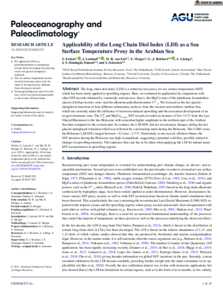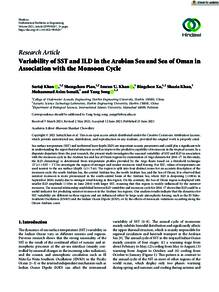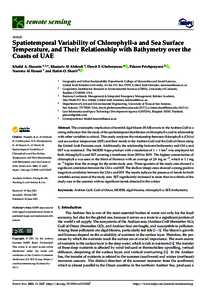وثيقة
Applicability of the long chain diol index (LDI) as a Sea surface temperature proxy in the Arabian Sea.
المعرف
DOI: 10.1029/2021PA004255
المصدر
Paleoceanography and Paleoclimatology. v. 36, 12, e2021PA004255
المساهمون
Lattaud, J., مؤلف
van Erk, M. R., مؤلف
Mezger, E., مؤلف
Reichart, G. -J., مؤلف
Lückge, A., مؤلف
Damsté, J. S. S., مؤلف
Schouten, S., مؤلف
الدولة
United States.
مكان النشر
New Jersey
الناشر
John Wiley and Sons Inc.
ميلادي
2021-12-01
اللغة
الأنجليزية
الموضوع
الملخص الإنجليزي
The long-chain diol index (LDI) is a relatively new proxy for sea surface temperature (SST) which has been rarely applied in upwelling regions. Here, we evaluated its application by comparison with other SST records obtained by commonly used proxies, that is, the Mg/Ca ratio of the planktonic foraminifera species Globigerinoides ruber and the alkenone paleothermometer UK´37. We focused on the last glacial–interglacial transition of four different sedimentary archives from the western and northern Arabian Sea, which are currently under the influence of monsoon-induced upwelling and the associated development of an oxygen minimum zone. The (Formula presented.) and Mg/CaG.ruber SST records revealed an increase of 0.6–3.4°C from the Last Glacial Maximum to the late Holocene with somewhat higher amplitude in the northern part of the Arabian Sea than compared to the western part. In contrast, the LDI SSTs did not reveal major changes during the last glacial–interglacial transition which was followed by a decreasing trend during the Holocene. The LGM versus the Holocene LDI SSTs ranged between −0.2 and −2.7°C. Particularly at one record, offshore Oman, the SST decrease during the Holocene was high in amplitude, suggesting a potential cold bias, possibly related to changes in upwelling intensity. This indicates that care has to be taken when applying the LDI for annual mean SST reconstruction in upwelling regions.
ISSN
2572-4517
قالب العنصر
مقالات الدوريات



